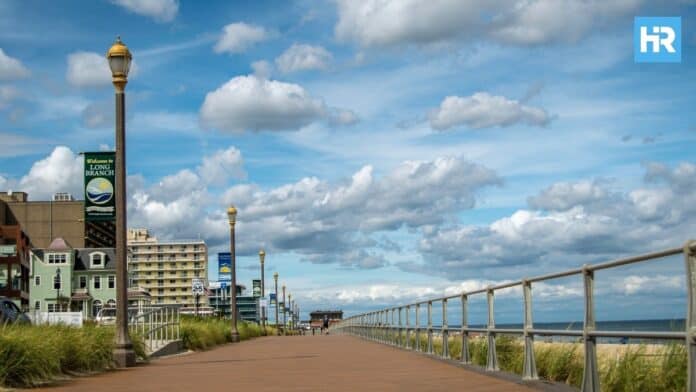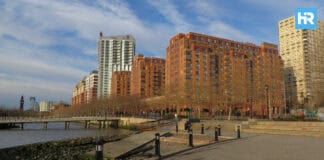The end of the year is almost here, and it’s time to get excited about the biggest party night of the year—New Year’s Eve!
Hoboken and Jersey City are ready to welcome 2025 with celebrations that suit everyone. It doesn’t matter what you’re into: fancy dinners, rooftop views, lively parties, or spending time with loved ones.
So, you’re guaranteed to find the perfect way to welcome 2025.
Let’s explore the best New Year’s Eve events in Hoboken and Jersey City so you can plan a night to remember and start 2025 on the ultimate high note.
- If you want amazing views and a classy party, go to Antique Loft at Riverview in Hoboken, where you can enjoy great food, an open bar, and the Manhattan skyline.
- For a big and glittery celebration, check out Madd Hatter’s All That Glitters Party on Washington Street, with nonstop music, drinks, and a fun crowd.
- For something special, hop on the Pier Pressure NYE Fireworks Cruise from Hoboken and enjoy drinks, music, and fireworks over New York City.
New Year’s Eve in Hoboken
Hoboken is the place to be when it comes to ringing in the new year.
Let’s take a stroll through Hoboken’s NYE scene and find your perfect party to enter 2025.
Spoiler: You’ll want to book fast—these are the most sought-after events in Hoboken.
1. Antique Loft at Riverview
Head to Antique Loft at 33-41 Newark Street for a classy evening with amazing views.
This rooftop spot offers a premium cocktail hour, a fancy dinner (yes, their famous bread pudding is on the menu), and a five-hour open bar.
The event starts at 7:30 PM and wraps up at 12:30 AM.
Tickets are $185, and the views of the Manhattan skyline alone are worth it.
2. Halifax NYE Disco 54 Extravaganza
If you love the glitz and glam of disco, Halifax at 225 River Street is where you need to be.
This Studio 54-themed party is about indulging with sushi, carving stations, fresh pasta, and an open bar.
The party kicks off at 9:30 PM and goes until 1 AM.
Tickets are $200, so dress up and get ready to dance the night away.
3. Madd Hatter’s “All That Glitters” Party
Check out Madd Hatter at 221 Washington Street for a wild, all-night bash.
Their “All That Glitters” party starts at 7 PM and goes strong until 6 AM.
Enjoy open bar packages, VIP table options, a live DJ, and complimentary champagne for the midnight toast.
It’s the perfect spot to party as if there’s no tomorrow.
4. Birch Hoboken Masquerade Party
In case you like the idea of a party with a little mystery, Birch, at 92 River Street, is hosting a masquerade party starting at 8 PM.
It includes a 4.5-hour open bar, a full dinner buffet, and DJ performances.
And at midnight, everyone takes their masks off for the big countdown.
5. Ainsworth Hoboken NYE Party
For a chic and fun NYE party, head to Ainsworth at 310 Sinatra Drive.
This stylish spot features an open bar, party favors, a live DJ, and a champagne toast at midnight.
There’s nowhere more fitting for a sophisticated yet lively celebration in Hoboken this year.
6. House of Que
If you love big party vibes with stunning NYC skyline views, House of Que at 340 Sinatra Drive is your spot.
This venue offers a five-hour premium open bar, DJ performances, and a high-energy crowd.
Gather your friends and dance into 2025 in style.
7. Fat Taco Tequila Bar
For a fun and festive atmosphere, check out Fat Taco at 32 Newark Street.
They offer a 4.5-hour open bar, a dinner buffet, music, giveaways, and champagne for the midnight toast.
Plus, you can catch the Times Square ball drop live on a big screen.
8. Black Bear Hoboken
If you’re looking for a lively crowd, head to Black Bear at 205 Washington Street.
With a five-hour top-shelf open bar, hors d’oeuvres, two floors of entertainment, and a huge 25-foot screen showing the ball drop, it’s one of Hoboken’s top party spots.
9. Willie McBride’s
For a more relaxed vibe, Willie McBride’s at 616 Grand Street offers an open bar from 9 PM to 3 AM.
You’ll also enjoy a hot buffet and a champagne toast at midnight.
Tickets are $125, making it a great option for a fun but laid-back evening.
10. Bin 14 Wine Bar
For a cozy and sophisticated celebration, Bin 14 at 1314 Washington Street is offering three dinner options with specialty dishes and festive drinks.
It’s a quieter way to enjoy New Year’s Eve while celebrating in style.
So, if you want a relaxed way to enter the New Year, this is where you’ll want to spend it.
11. Anthony David’s
If fine dining is your thing, Anthony David’s at 953 Bloomfield Street is probably the best spot for you.
They have multiple seating options, starting at $70 for early diners.
Later seatings include a four-course menu for $125, complete with a champagne toast and party favors.
12. Pier Pressure Hoboken NYE Fireworks Cruise
Do you want something a little different?
The Pier Pressure Cruise leaves from 1301 Sinatra Drive at 8:30 PM and sails until 1:30 AM.
You’ll enjoy stunning views of the NYC fireworks, a premium open bar, and an unforgettable experience on the water.
13. Hudson Golf
For a unique way to celebrate, check out Hudson Golf at 16 Hudson Place.
This spot offers entertainment and a lively atmosphere from 9 PM to 1 AM to kick off the new year.
14. Brightside Tavern
If you’re looking for a casual and fun night, Brightside Tavern is hosting karaoke, dancing, and a midnight champagne toast.
It’s the perfect low-key way to celebrate with friends.
New Year’s Eve in Jersey City
Jersey City knows how to throw a party, whether you’re after killer skyline views, captivating live music, or fancy dinners.
If you’re ready to wave goodbye to 2024 in style (and maybe with a little champagne buzz), here’s the ultimate rundown of the best spots to make your NYE one for the books.
1. Zeppelin Hall
Casual, fun, and all about good vibes—Zeppelin Hall at 88 Liberty View Drive is your no-frills New Year’s Eve destination.
The party kicks off at 8 PM, and the best part is there’s no cover charge.
With a live DJ spinning all night, plenty of space to dance, and a lively crowd ready to celebrate, this spot is for anyone who wants to let loose without breaking the bank.
Grab a drink, hit the dance floor, and keep it simple—it’s all about good times here.
2. Battello Après Midnight Party
Now, if you’re feeling fancy (like black-tie fancy), Battello at 502 Washington Boulevard is where you’ll want to be.
Their Après Midnight Party is pure alpine glamour with a side of waterfront sophistication.
Doors open at 8:30 PM, and for $250, you get a premium open bar, gourmet bites, passed hors d’oeuvres, and a midnight champagne toast that’s nothing short of iconic.
Oh, and did I mention the views? Snap some skyline selfies because this place serves major photo ops.
3. White Eagle Hall
For all you live music junkies, White Eagle Hall at 337 Newark Avenue is bringing the heat this year.
They’ve got Gogol Bordello and Crazy & the Brains lined up to tear the house down starting at 8 PM.
This historic venue is dripping with charm, and the energy is guaranteed to be electric.
If you’re looking for a night of raw, high-energy performances, this is where the party’s at.
4. Rooftop at Exchange Place
Let’s talk about rooftop magic for a second.
The Rooftop at Exchange Place, perched at 1 Exchange Place, offers one of the best views in the game.
From 7 PM to 2 AM, you can dance under the stars, sip cocktails, and soak in Instagram-worthy sights of the Manhattan skyline.
Tickets start at $35, but if you want to go all out, spring for a VIP table—it’s worth it for the champagne and prime seating alone.
It’s classy, cool, and unforgettable, so of course, it had to make this list.
5. Porto Leggero
Feeling fancy but still want to keep it intimate?
Porto Leggero, at 185 Hudson Street, offers a four-course prix-fixe menu for $100 that will have your taste buds thanking you.
This place nails the balance between upscale and cozy, making it perfect for a romantic dinner or a quiet celebration with your closest friends.
Refined, relaxed, and ridiculously delicious—what’s not to love?
6. Felina Steak
You’re in for a treat at Felina Steak, 2 Chapel Avenue.
This spot is about mouthwatering dishes and expertly crafted cocktails in a sleek, modern setting.
It’s sophisticated without feeling stuffy, so you can enjoy an elevated celebration that still feels fun.
7. Liberty Prime Steakhouse
If your idea of celebrating is eating your way into 2025, then Liberty Prime Steakhouse has you covered.
With a warm, inviting vibe and a multi-course dinner menu that’s nothing short of indulgent, this is the place to go if you want a low-key but luxurious evening.
Perfect for couples or small groups, you’ll find great food, great drinks, and even better company.
8. Lokal JC
Lokal JC at 2 2nd Street is your go-to for a mix of trendy vibes and stellar entertainment.
With curated dishes, craft cocktails, and an electric party atmosphere, this is where elegance meets excitement.
It’s the perfect backdrop for a night of laughter, dancing, and maybe a few too many boomerangs for your Insta story.
9. Orale Mexican Kitchen
Bring the fiesta energy to your New Year’s Eve at Orale Mexican Kitchen on 341 Grove Street.
This spot serves up a four-course menu, an open bar, DJ vibes, and a midnight toast.
It’s festive, colorful, and guaranteed to keep the party going long after the clock strikes twelve.
If you’re ready to spice up your NYE, this is your jam.
10. Dullboy
For something a little more chill (but still plenty cool), check out Dullboy at 364 Grove Street.
Their “Straight Outta Jersey City” celebration includes a four-course menu, an open bar, giveaways, and a special toast at midnight.
It’s got a trendy, intimate vibe that’s perfect for kicking back while still feeling like you’re part of something special.
11. Faubourg Weehawken
Okay, so this one’s technically in Weehawken, but it’s worth the short trip.
Faubourg, at 1100 Avenue at Port Imperial, hosts an elegant four-course prix-fixe dinner for $145.
This place screams luxury, and the food is next-level.
So, if you want to start 2025 feeling fancy and fabulous, this is the way to do it.
Celebrate Your New Year in Style
Now that you’ve seen all the incredible options Hoboken and Jersey City have to offer, it’s time to decide how you’ll ring in the new year.
Think about what kind of night feels right for you. Maybe you’ll sip cocktails while soaking in the Manhattan skyline at a rooftop party.
Perhaps you’ll board a luxury cruise to watch the fireworks light up the night sky over New York City.
Or you might want to join a lively crowd at a local bar and dance to your favorite tunes until midnight.
For families, there are even kid-friendly celebrations where everyone can share the joy of welcoming the new year together.
But don’t wait too long.
These events are popular, and tickets for the most sought-after spots are already going fast.
Secure your plans now so you don’t miss out on your top pick.
Call your friends, reserve your table, grab your party tickets, and start thinking about what you’ll wear—it’s all part of the fun.
















